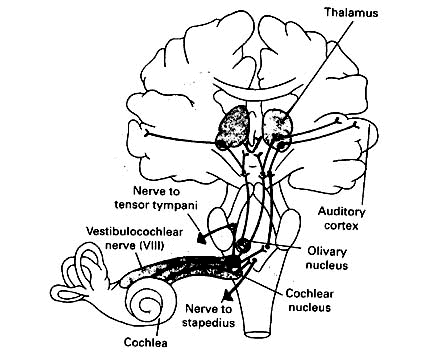Cochlear Pathways
Many neural signals are initiated by a stimulus to a defined set of receptors on one side of the body. These signals travel through the nervous system and are usually interpreted in the side of the brain opposite the side where the stimulus was received. For example, if someone is pinched on the left hand, the neural signals initiated by the pinch travel to the spinal cord. These impulses enter the left side of the spinal cord and cross over to the right side of the brain. They are now on the opposite, or contralateral, side of the nervous system from where they were initiated. These impulses will now be processed on the right, not the left, side of the brain. The auditory pathway has bilateral input, receiving information from both ears. Much of our ability to extract information from sound is based on comparisons of the slight differences detected by each of our ears. The auditory signal leaves the cochlea and travels down the eighth cranial nerve terminating in the cochlear nucleus in the brainstem. Axons from neurons within the cochlear nucleus carry the signal to the olivary nucleus. Sound comparisons are carried out in the olivary nucleus, groups of neurons located on either side of the brainstem. Cells in the olivary nuclei receive input from both ears. They also are capable of comparing the slight differences in time when a sound arrives at each ear and differences in the sound's intensity as perceived by each ear. So if the sound is closest to the right side of the body, it will arrive at the right ear before it arrives at the left ear and also be more intense on the right side. These tiny differences in time and intensity help the brain pinpoint the location of a sound.

A cell, or group of cells, compares something like the time of arrival or intensity of a signal. When a stimulus arrives in the left ear first, its auditory signal reaches the olivary nucleus before the stimulus from the right side. This means that the signal from the left ear is able to travel farther down the line of neurons than the signal from the right ear before signals from both sides converge on a single neuron. This capacity appears to be partly influenced by learning; it is experience that helps teach an individual how to recognize the direction of a sound. Conversely, this mechanism makes it difficult to determine whether a sound originates directly in front or directly in back without using other senses, such as sight or touch. A sound coming from the front or back will arrive in both ears simultaneously, but be processed differently from sound received at the side.

© David G. Ward, Ph.D. Last modified by wardd 23 May, 2006